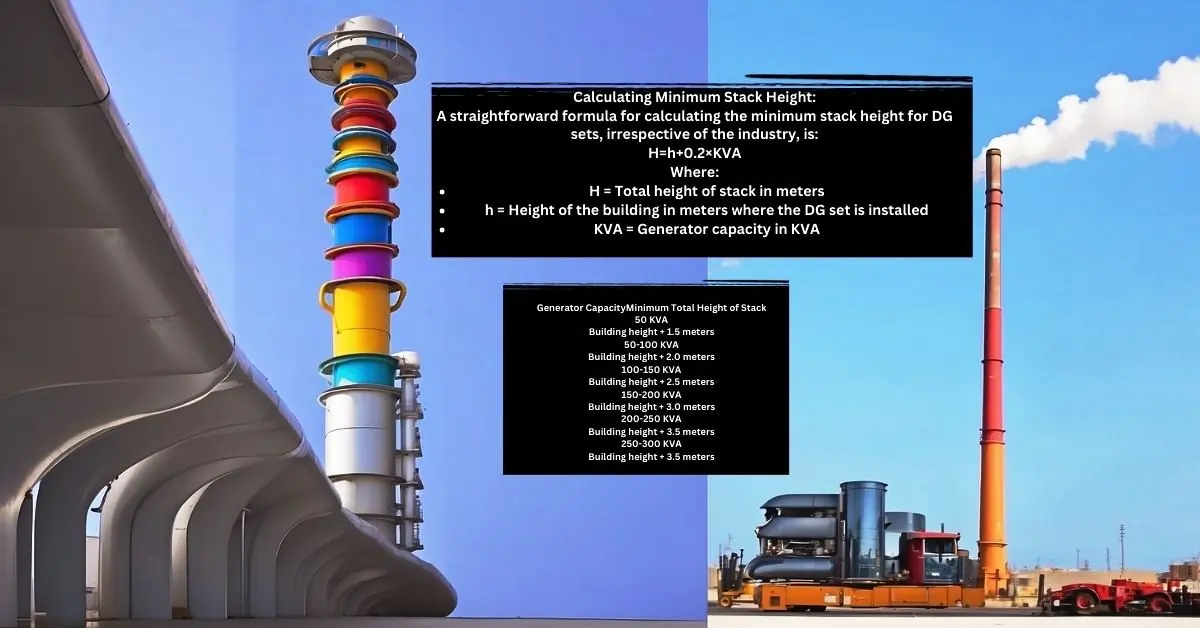Understanding CPCB Norms for DG Sets: Balancing Power and Planet
“What Is Exhaust Stack Height Of DG Set” might initially seem like just another item on the list of Central Pollution Control Board (CPCB) regulations for diesel generators (DG sets), but it’s a crucial aspect of safely operating these power sources. Navigating the CPCB regulations ensures that the use of DG sets doesn’t harm the environment or public health. These regulations cover a wide array of standards, from controlling the maximum noise levels a DG set can emit to setting limits on airborne emissions.
Understanding and implementing the correct exhaust stack height is part of the effort to strike a balance between our need for reliable backup electricity and our responsibility to protect the air we breathe and the environment. By following these guidelines, including ensuring the appropriate exhaust stack height for effective emission dispersion, businesses and individuals contribute to reducing pollution and improving air quality in our cities.
Central Pollution Control Board (CPCB)

What is a Stack?
A stack, commonly known as a chimney, serves the purpose of releasing hot air, emissions, and particulate matter from sources like boilers and flue gases into the atmosphere at significant heights. By dispersing pollutants at these elevated levels, the contaminated air spreads over a wide area, ensuring that ground-level concentrations remain within safe limits and pose no threat to humans, animals, and plants. There are various kinds of flue-gas stacks, each designed according to the type of fuel injection system they accommodate. Examples include DG set stacks, flue gas stacks, process stacks, furnace stacks, boiler stacks, and chimneys.
What Is Exhaust Stack Height Of DG Set
When setting up diesel generator sets (DG sets), calculating the correct exhaust stack height is crucial for the effective dispersion of emissions and compliance with environmental regulations. The stack height plays a pivotal role in reducing the impact of pollutants on air quality and human health. Several factors must be considered to determine the optimal stack height for DG sets:
- Emission Rate: This is the rate at which pollutants are emitted, usually specified by the manufacturer in kilograms per hour or grams per second. It’s a key parameter in stack height calculation.
- Exit Velocity: The speed at which exhaust gases exit the stack affects the plume’s initial rise. Higher velocities lead to a higher plume rise.
- Stack Diameter: The diameter of the stack or exhaust duct influences how emissions disperse. Larger diameters can improve dispersion.
- Exit Temperature: Hotter exhaust gases rise more quickly, so the temperature at which gases exit the stack impacts the plume rise.
- Ambient Conditions: Ambient temperature and wind speed significantly affect pollutant dispersion and dilution in the atmosphere.
- Buoyancy Factor: This factor, determined by comparing exit to ambient temperature, influences plume behavior and dispersion.
- Surrounding Environment: The height of nearby buildings and the terrain can affect emission dispersion patterns. Obstructions may require a taller stack.
- Regulatory Requirements: Local and national guidelines may set minimum stack height requirements to meet air quality standards.
Dispersion modeling tools and consultations with environmental experts are often employed to calculate the necessary stack height, ensuring compliance and minimizing emissions’ impact.
DG Set & Exhaust System Setup Guide
The process includes the design, supply, and installation of an exhaust pipe with a stack up to 40 meters high, equipped with suitable thickness cladding for durability.
For rain protection of the exhaust ducting, features such as a 90-degree bend with bird mesh, a protective cowl, or a special diffuser are recommended. The design ensures that the horizontal run of exhaust piping slopes downwards away from the engine to prevent rainwater or condensate from entering. Additionally, a condensate drain pipe is installed in the horizontal ducting after the silencer as an added measure against water entry to the engine.
Regarding the silencer location, positioning it close to the engine is advised to enhance sound attenuation.
The foundation for the DG set must be designed to handle the soil’s safe bearing capacity along with the generator’s static and dynamic loads. To minimize vibration and noise spreading to nearby structures, Anti-Vibration Mounts (AVMs) are used. The foundation’s depth should be determined through discussions between the customer and a certified structural engineer, taking into account the DG set’s loads and the soil’s condition.
For information on the static and dynamic loads of the DG Set, please reach out to the Generator Original Equipment Manufacturer (GOEM). The foundation’s dimensions should exceed the size of the acoustic enclosure or base rails by at least 150 mm (6 inches). It’s crucial to wait for the concrete to fully set and harden before placing the generator set on it.
Calculating Minimum Stack Height:
A straightforward formula for calculating the minimum stack height for DG sets, irrespective of the industry, is:
H = h+0.2 x √ KVA
Where:
- H = Total height of stack in meters
- h = Height of the building in meters where the DG set is installed
- KVA = Generator capacity in KVA
This formula provides a clear guideline for determining stack height, ensuring effective emission control. Here are the minimum stack heights based on generator capacity:
| Generator Capacity | Minimum Total Height of Stack |
|---|---|
| 50 KVA | Building height + 1.5 meters |
| 50-100 KVA | Building height + 2.0 meters |
| 100-150 KVA | Building height + 2.5 meters |
| 150-200 KVA | Building height + 3.0 meters |
| 200-250 KVA | Building height + 3.5 meters |
| 250-300 KVA | Building height + 3.5 meters |
This table provides a straightforward guideline for determining the necessary stack height to ensure effective emission control for different capacities of diesel generators.
FAQ on What Is Exhaust Stack Height Of DG Set
Q: What does the exhaust stack height of a DG set refer to?
A: It refers to the vertical distance from the base to the top of a DG set’s exhaust pipe, crucial for dispersing emissions safely.
Q: Why is the correct exhaust stack height important for DG sets?
A: Proper height ensures harmful emissions are dispersed effectively, minimizing environmental and health impacts.
Q: How is the exhaust stack height for a DG set determined?
A: It’s calculated based on factors like emission rate, local regulations, and surrounding environmental conditions.
Q: Can I adjust the exhaust stack height of my DG set?
A: Yes, adjustments can be made to comply with regulations and optimize emission dispersion, but it should be done by professionals.
